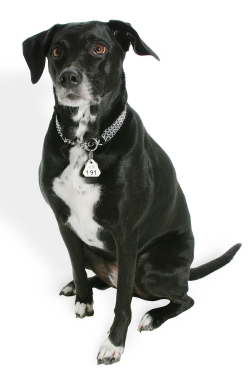Adopting an Adult Dog

Adopting an adult dog can be a marvelous alternative to raising and training a puppy. Alternatively, a new adult dog can be a full-time project. Adult dogs can be perfect or problematic — carrying the behavioral benefits or baggage of their previous owners.
Take your time to search for the right dog for you and only choose one that you know your family knows how to train. Some shelter and rescue dogs are purebred, but most are one-of-a-kind mixed-breeds.
Some shelter dogs are well trained, well behaved, friendly, and simply in need of a caring human companion. Others may have a few behavior problems (housesoiling, chewing, barking, hyperactivity, etc.,) and require their puppy education in adulthood. Other dogs are shy and fearful and require a dedicated owner who is going to spend the time that it takes to rebuild the dog's confidence.
Raising and training a puppy requires a lot of time and know-how. The puppy's behavior is always changing, for better or for worse, depending on his socialization and training. However, an adult dog's behavior and temperament are already well established, for better or for worse. Traits and habits may change over time, but compared with the behavioral plasticity of young puppies, an older dog's habits are much more resistant to change. Whereas temperament problems may take longer to resolve in an adult dog, good habits are also just as hard to break. Thus the key to adopting a good shelter or rescue dog depends on selection, selection, selection! Take your time to test drive plenty of prospective candidates. The perfect dog is waiting for you somewhere. Be patient, search well, and be realistic about your choice, i.e., choose with your brain as well as your heart. When selecting an adult dog, you need to evaluate whether you like the dog, whether the dog likes you (and other people), and the dog's basic manners and household etiquette.
Mutual Affection
All family members must be involved in the selection process and agree 100% on the final choice. You must equally check that the dog likes all family members. Make sure that the dog eagerly approaches each family member and thoroughly enjoys being handled and stroked. Additionally, check that the dog likes other people. Observe the dog's behavior when he interacts with a wide variety of people, especially children, men, and strangers. The most important quality in a companion dog is friendliness: he should enjoy the company and attentions of people. If he is at all fearful or standoffish, you will need to devote time to teach him that people are non-threatening.
Test-Driving
Make sure that you get a good feel for your prospective dog before you take her home. First, check her general demeanor. Is her kennel soiled or clean? Does she play with chewtoys? Is she calm and quiet, or hyperactive and barking? Make sure all family members spend plenty of time "test-driving" the dog. Check to see that everyone can get the dog to pay attention, come when called, sit, lie down, and roll over. Take the dog for a spin around the block to evaluate how she walks on leash. Especially spend lots of time handling and petting (examining) and hugging (restraining) the dog. Check that she enjoys having her muzzle, ears, neck (and collar), paws, and rear end handled. If you find she has areas that are sensitive to touch, check to see how she responds to progressive desensitization exercises. There is little point in sharing your home with a dog that you (or others) cannot touch.
Your Dog's First Couple of Weeks at Home
An environmental change offers a wonderful opportunity for a dog to learn new household rules. First impressions are extremely important and leave an indelible impression. Regardless of your new dog's presumed housetraining and chewtoy-training status, teach her where to eliminate, what to chew, and how to settle down calmly and quietly during her first couple of weeks at home. In the beginning, your dog is likely to be somewhat stressed with all the recent changes in her life. She may be depressed, or she may react with exuberance (hyperactivity and barking) in her newfound home. She may become anxious (bark, chew, pee, and poop) when left alone.
It is incredibly important that your dog does not establish any bad habits during her first couple of weeks at home. Consider a short-term and long-term confinement program (see Puppy’s First Month: Home Alone), so that housetraining and chewtoy-training are errorless. For the time being, do not feed your dog from a food bowl. Instead, have family, friends and strangers handfeed most kibble as training lures and rewards for housetraining, classical conditioning, and teaching basic manners. Stuff the rest of her kibble into Kongs to teach her to settle down quietly, calmly, and confidently. Once your dog adapts to her new surroundings and human companions, she has a lifetime to enjoy full run of her new home.
Fearful Dogs
Many dogs are undersocialized and may become fearful in the shelter environment. You are a saint to rescue a fearful dog from the stress of a shelter environment, but you must realize that for fearful dogs, confidence-building can be an extremely lengthy and heart-rending procedure. You must have both the time and the know-how. The last two dogs that I adopted were fearful and aggressive toward men and strangers. Both dogs became friendly and confident but each one required a couple of years work to help them reach that goal. (For information on how to rehabilitate a fearful dog read Help For Your Fearful Dog by Nicole Wilde.) To learn more about training, read the Open Paw Four-Level Training Manual and Doctor Dunbar's Good Little Dog Book. To locate adolescent and adult dog training classes in your area, contact the Association of Pet Dog Trainers
A good place to search for the right dog for you is the Dogtime matchup.




